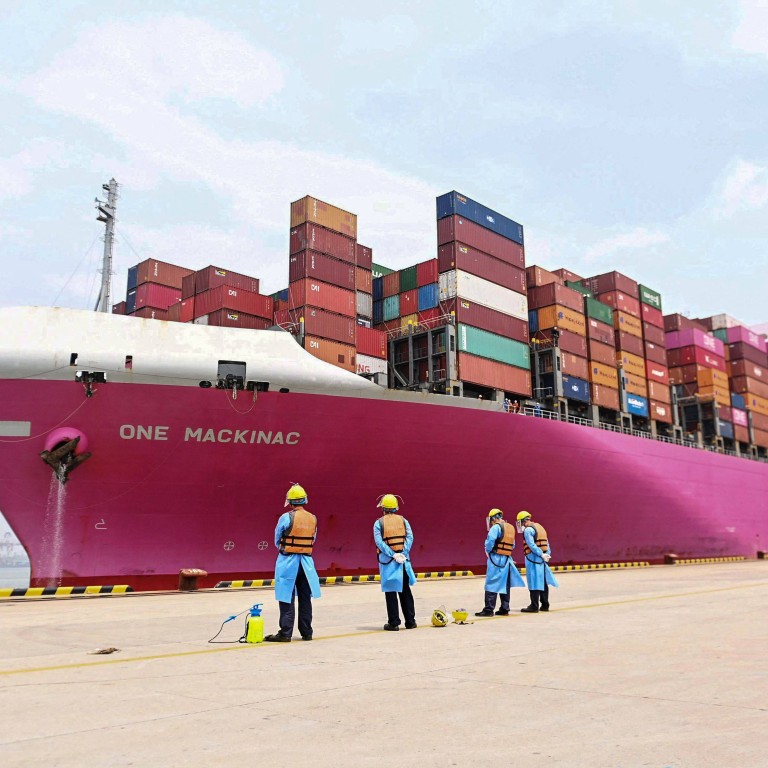
China trade: exports continue as ‘best performing economic engine’, but is it the ‘last hurrah’?
- China’s exports grew by 17.9 per cent in June compared with a year earlier, while imports grew by 1 per cent last month
- China’s imports from Russia surged by 56.3 per cent to US$9.7 billion in June compared to a year earlier
China’s export machine might have enjoyed its “last hurrah” despite continued growth last month with overseas demand set to cool and the shadow of coronavirus restrictions looming in the second half of the year, analysts warned.
Imports, however, grew by just 1 per cent last month from a year earlier to US$233.3 billion, down from 4.1 per cent growth in May.
“As the demand in developed countries shifts towards services from goods, the strong export growth may not be sustainable in the second half of the year,” said Zhang Zhiwei, chief economist at Pinpoint Asset Management, noting June’s exports received a boost from the reopening of Shanghai after a two-month lockdown.
We think this may be the last hurrah for China’s pandemic export boom before shipments drop back on cooling demand
The easing of shipping bottlenecks also contributed, according to Julian Evans-Pritchard, senior China economist at Capital Economics.
“But we think this may be the last hurrah for China’s pandemic export boom before shipments drop back on cooling demand,” he said.
He added that high inflation and rising interest rates in key markets for Chinese goods will also weigh on consumer purchasing power, while the reversal of coronavirus-induced shifts to consumption patterns will provide an additional headwind.
“Import volumes may fare slightly better going forward as the domestic economy recovers from the recent virus wave. But inbound shipments are still likely to remain soft given relatively modest policy support and continued deleveraging among property developers,” he said.
China’s total trade surplus rose to a record US$97.94 billion in June, compared with US$78.76 billion in May.
Iris Pang, chief economist for Greater China at ING, expects China’s imports to grow faster and the export recovery to continue until the US economy cools.
“This has a precondition that long lockdowns in key cities in China will not be repeated,” she said.
Meanwhile, China’s imports from Russia surged for a fifth straight month since the invasion of Ukraine, in a fresh sign of the closer trade ties between the two neighbours amid their growing geopolitical tensions with the West.
China’s trade development still faces unstable and uncertain factors, and there is still a lot of pressure to maintain stability and improve quality
Imports surged by 56.3 per cent to US$9.7 billion in June compared to a year earlier, but exports declined for a fourth straight month after dropping by 17 per cent to US$5 billion, according to calculations based on the customs data.
This led to China’s trade deficit with Russia to expand by nearly 22 times from a year earlier to US$4.7 billion.
“The Covid-19 pandemic and the international environment are currently becoming more severe and complex. China’s trade development still faces unstable and uncertain factors, and there is still a lot of pressure to maintain stability and improve quality,” said Chinese customs spokesman Li Kuiwen.
But Li said that China’s trade is still expected to maintain steady growth in the second half of the year.
In June, China’s trade surplus with the US grew by 27 per cent from a year earlier to US$41.4 billion, up from US$36.1 billion in May.
“While any easing in US tariffs will be positive for China’s exports, the impact will probably be modest, especially given the slower growth in the US that we expect,” said Tommy Wu, lead China economist at Oxford Economics.
He warned that renewed coronavirus restrictions in a number of Chinese cities since early July could pose a downside risk to the near-term outlook for exports.
Cancel tariffs and don’t impose new trade measures, commerce ministry urges US
“Still, we believe that possible future disruptions will likely be less severe than the Shanghai lockdown,” he said.
China’s imports from the European Union fell by 9.7 per cent to US$25 billion in June, while exports grew by 17.1 per cent to US$50.5 billion.
China’s exports to the Asean countries grew by 29 per cent in June, compared with a year earlier, to US$52.1 billion, while imports rose by 5.3 per cent to US$35.5 billion.
China’s imports of coal, crude oil, refined oil and natural gas all declined last month, with coal specifically falling by 33.1 per cent compared to a year earlier.
But in US dollar terms, the spending in each sector increased, with crude oil rising by 43.9 per cent compared to a year earlier, highlighting inflation distortion on trade.

